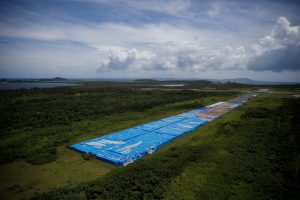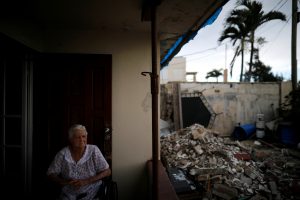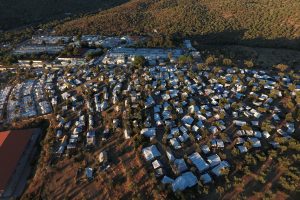
By Luis Valentin Ortiz
SAN JUAN (Reuters) – Shuttered businesses, blue tarp roofs and extensively damaged homes can still be seen throughout Puerto Rico a year after Hurricane Maria ripped through the island with 150 mile-per-hour winds, and access to electricity and fresh water remain spotty.
Last month, the U.S. Commonwealth’s government sharply raised the official estimate of Maria’s death toll to almost 3,000 after an independent study. The exact death toll figure remains unknown, and the governor has admitted his administration failed to properly record storm-related deaths.
Meanwhile, U.S. President Donald Trump has refused to accept the new number and continues to joust with many local officials and other critics who complain that the federal response to the storm was inadequate.
“Today is a day to remember those who are not physically with us but left a significant mark after their departure. Hurricane Maria took with it many lives that we will not overlook and that we still remember with a great weight of pain,” Governor Ricardo Rossello said Thursday ahead of a planned memorial event: “One Year After Maria” with religious leaders and government officials.

About 20,000 pallets of unused water bottles are seen along an airplane runway a year after Hurricane Maria devastated Puerto Rico in Ceiba, Puerto Rico, September 18, 2018. Picture taken September 18, 2018. REUTERS/Carlos Barria
U.S. Housing & Urban Development (HUD) Secretary Ben Carson was also on the island, where he was expected to give an update on his agency response efforts to Hurricane Maria.
The storm knocked out power and communications to virtually all of Puerto Rico’s 3.2 million residents while destroying the homes of thousands.
Even before the Category-4 storm hit, Puerto Rico was financially bankrupt with $120 billion in debt and pension liabilities it cannot pay. A year after Maria, the island is far from prepared for the next big storm, with an ever-fragile power grid, damaged infrastructure and the same crippling debt.
The island’s government initially put the death toll at 64, but the August study by George Washington University estimated that Maria killed 2,975 people either directly or indirectly from the time it struck in September 2017 to mid-February.
Trump has described his administration’s response to the disaster as an “unsung success” and “one of the best jobs that’s ever been done.” He further said that “3000 people did not die” following Hurricane Maria.
“If he calls a success or an unsung success 3,000 people dying by his watch, definitely he doesn’t know what success is,” San Juan Mayor Carmen Yulin Cruz, a vocal Trump critic, told Reuters during a recent interview.

Lucila Cabrera, 86, sits at the porch of her damaged house by Hurricane Maria, a year after the storm devastated Puerto Rico, near Barceloneta, Puerto Rico, September 18, 2018. Picture taken September 18, 2018. REUTERS/Carlos Barria
BRACING
More than 200,000 people left the island after the storm, mostly to the U.S. mainland, according to government data.
There are still some 45,000 homes with so-called “blue roofs,” or tarps installed by the Federal Emergency Management Agency (FEMA). The San Juan mayor has noted that the island has seen only a fraction of almost $50 billion in recovery funds Congress approved for Puerto Rico, including $20 billion in HUD funds.
“Most of the people that have requested help from FEMA … have not received enough assistance to be able to take care of their problems,” Mayor Cruz said, adding that “a lot of people that don’t have a title deed and they really are not eligible to receive any type of support or help.”
The recovery process after Maria has also seen hundreds of community-driven efforts. During a forum held on Wednesday by the nonprofit Center for Investigative Journalism, community leaders urged for a multisectoral approach to the recovery, rather than a government-only-led effort, which has proven slow and full of missteps.
“We lost people, roofs and houses, but our community worked hard to get back on its feet,” said Wilfredo Lopez, a community leader of the Sonadora neighborhood in Aguas Buenas, which had disaster-trained residents and its own protocols in place before the storm hit.
(Reporting By Luis Valentin Ortiz; Editing by Daniel Bases and David Gregorio)














